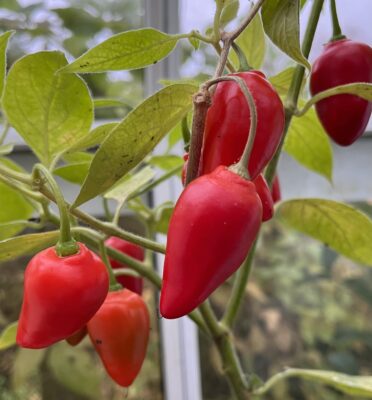
This image is a testament to climate change! Harvest any crops which remain in the unheated greenhouse.
Start Amaryllis bulbs into growth as soon as you can, watering sparingly at first; just trickle a little tepid water around the bulb, increasing the amount as the bud appears. Once it is growing strongly, keep the compost moist but not waterlogged and the point where the bud appears from the bulb, perfectly dry. They need temperatures around 20C so when it’s time to make the move from the greenhouse, put the pot on a warm sunny windowsill but don’t leave them between the curtains and window at night. They flower for longer when room temperatures are consistently moderate, so keep them away from the heat of radiators. Stake the flowering stems carefully to prevent it from falling over, rotate the pot a quarter of a turn each day, then sit back and enjoy the glorious trumpet flowers.
Open greenhouse vents for as long as possible on mild sunny days, but close them before temperatures drop in early afternoon. High temperatures and low light encourage soft spindly growth and grey mould which loves cool, damp conditions. Keep the air circulating on cooler days with the help of a thermostatically controlled electric fan.
Christmas or Boxing Day are traditional dates for sowing Onion seeds. Space them evenly over the surface of moist seed compost in trays or modules, and lightly cover with fine grade vermiculite. Put the tray in a heated propagator at 20C (70F) and they will germinate in 10-14 days. Then grow them on in a cool greenhouse.
Take root cuttings from plants, like Oriental Poppies, Phlox, Verbascum, ‘Drumstick’ primula’s, shrubs like ‘Japanese Quince’ and exotic ‘Passion Flowers’. It is an inexpensive yet rarely used method of propagating plants. Once the leaves have fallen and plants are dormant take a hand fork and carefully tease the soil from around the plant to expose some of the roots. Cut off any side roots near to the main stem, they should be at least ¼” diameter and as long as possible, but don’t take too many or it weakens the plant. Cuttings need to be 2-6” long, so take them slightly longer and trim on the potting bench.
Wash off any soil and cut off any fibrous roots. Ising a sharp knife, make a horizontal cut at the end nearest the main stem and an angled cut at the opposite end, so you can tell which is the top and bottom, then dust the cuts with fungicide like sulphur to prevent rotting.
Fill a pots of peat substitute compost with added grit, and make several holes about 2” apart with a pencil, cane or dibber, insert the cuttings, with the horizontal end just visible at the top, then cover with a thin layer of grit and water. From then on keep the compost moderately moist, don’t overwater or the roots may rot. Label with the plant name and date. They take a couple of months to root in a cold frame or cool greenhouse; in a propagator at 65-70 deg F, they will root in a month to six weeks. Water through next summer to encourage them to grow, feed monthly with a general fertiliser, pot on if needed and plant them out the following autumn.
A Happy festive season to you all. Matt.


